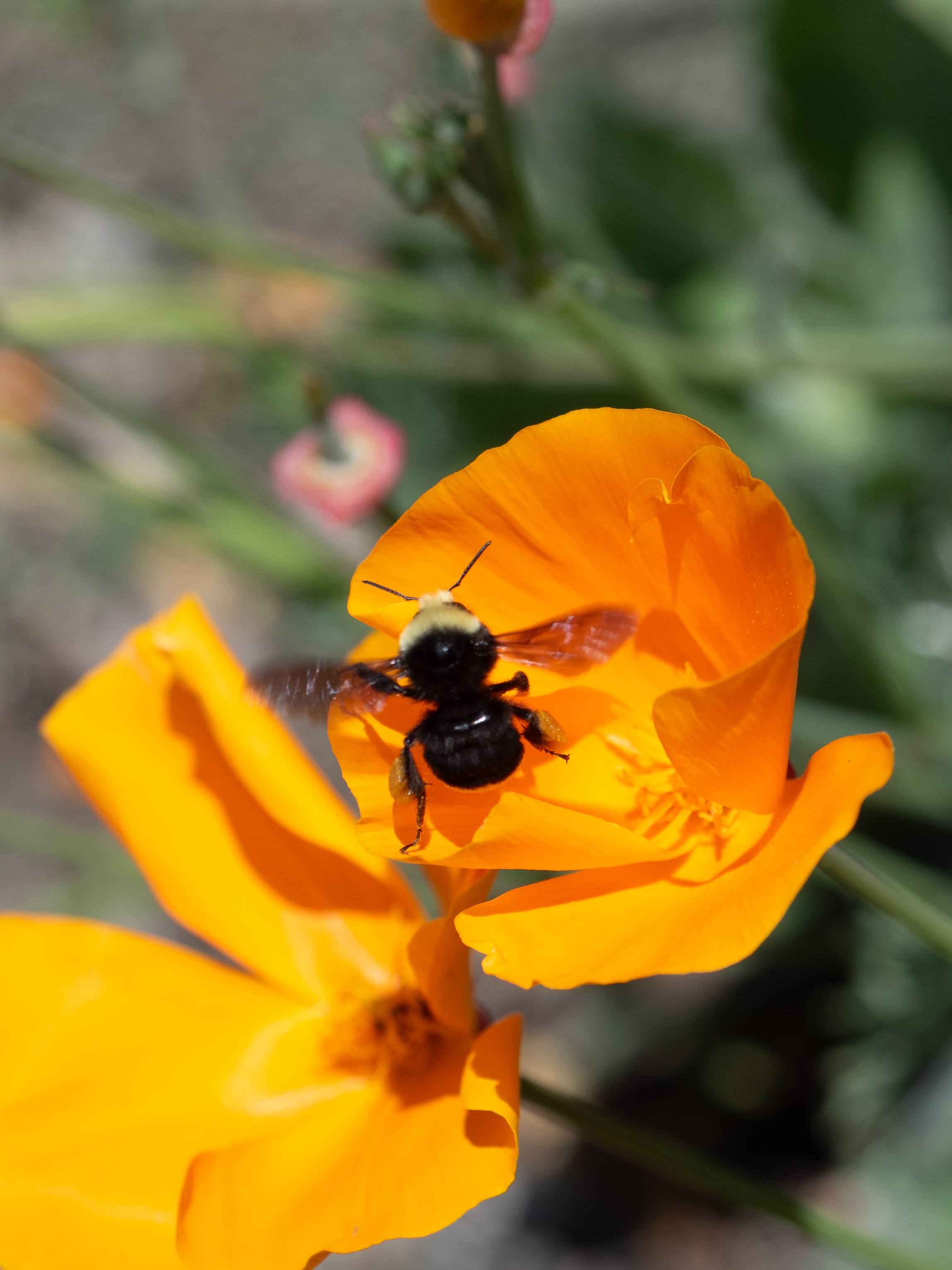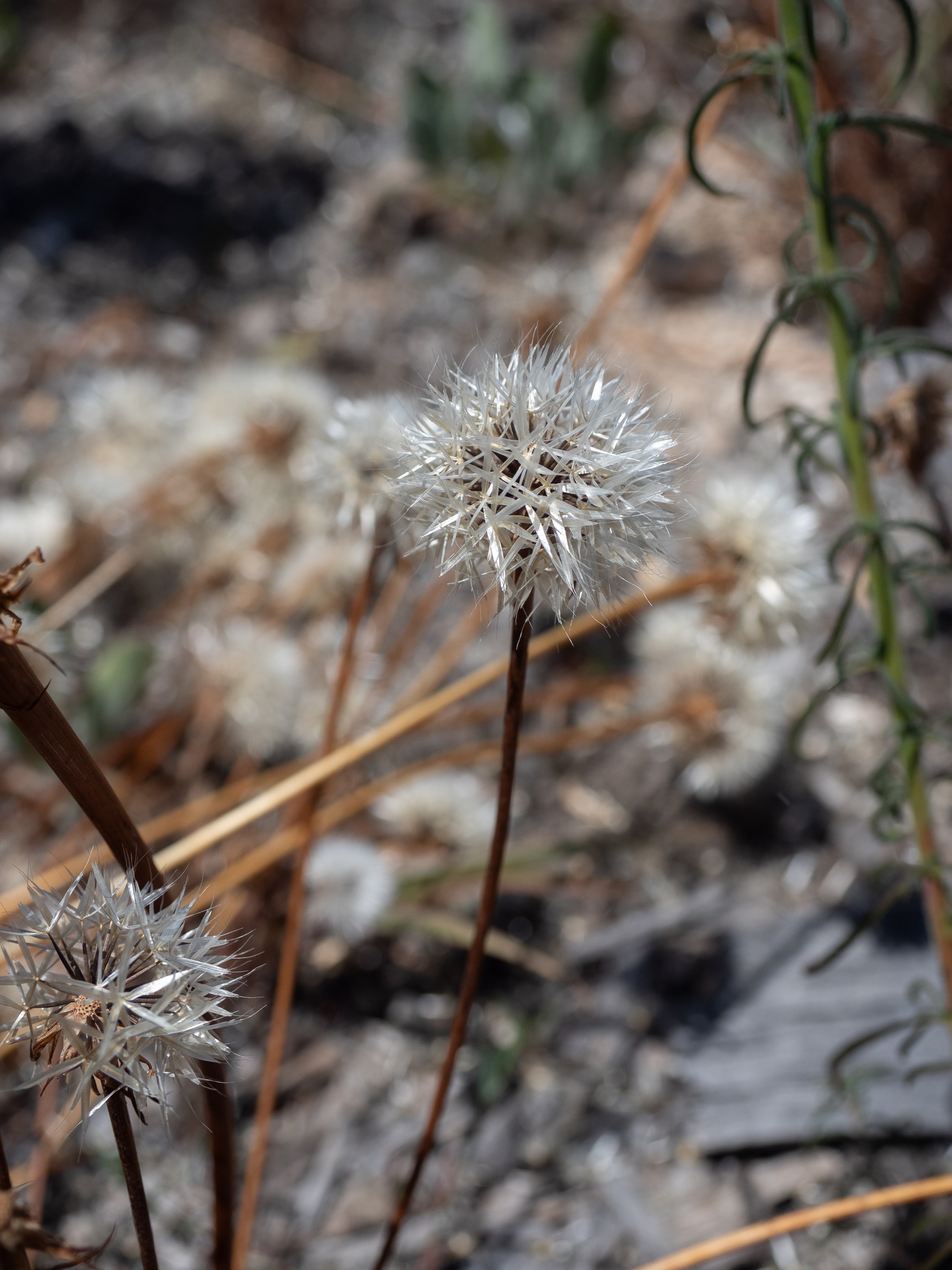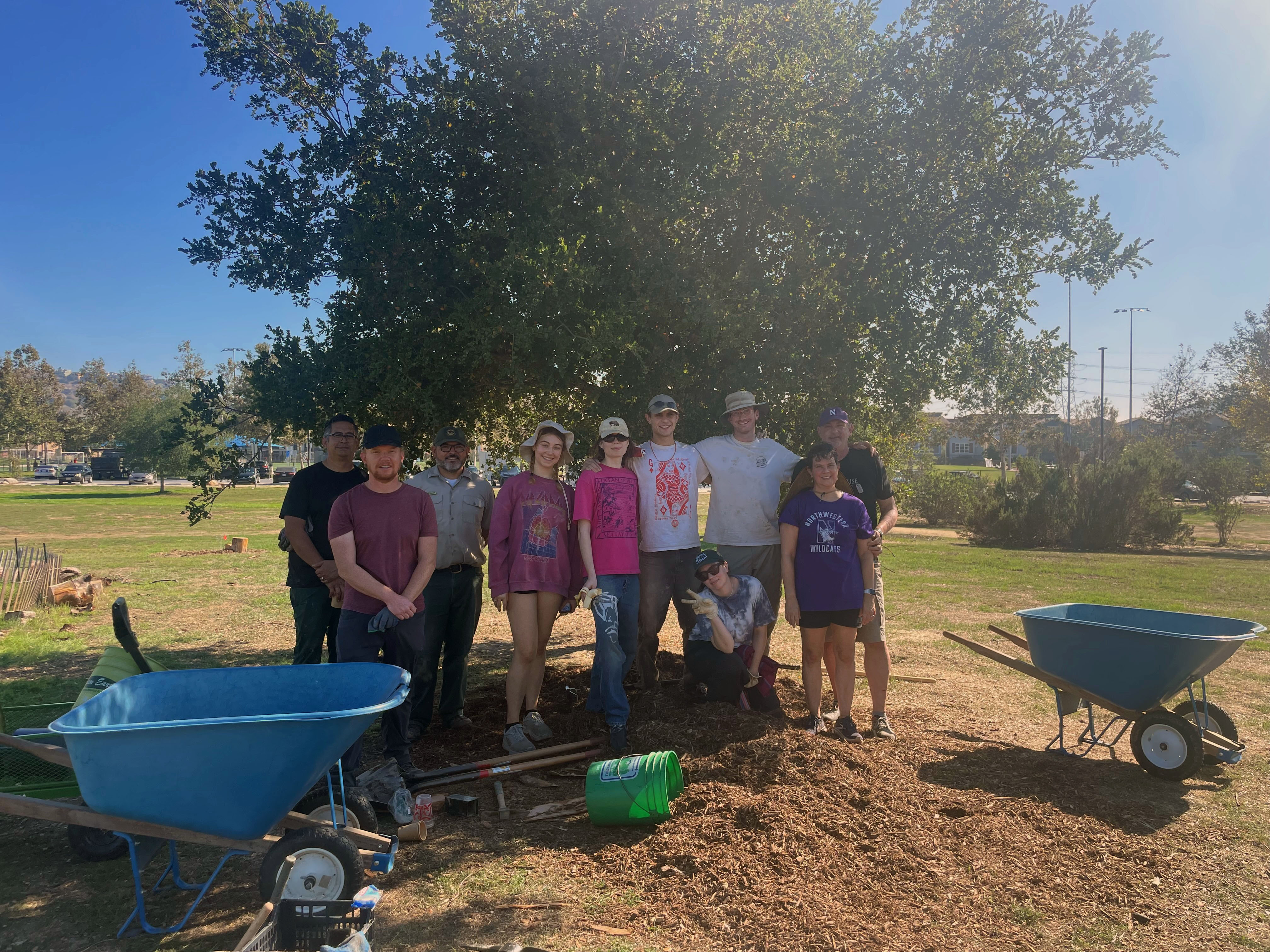
PLANTING AN OAK GROVE
Rio de Los Angeles Test Plot
By Tom Hurst
DATE: Nov 09 2025
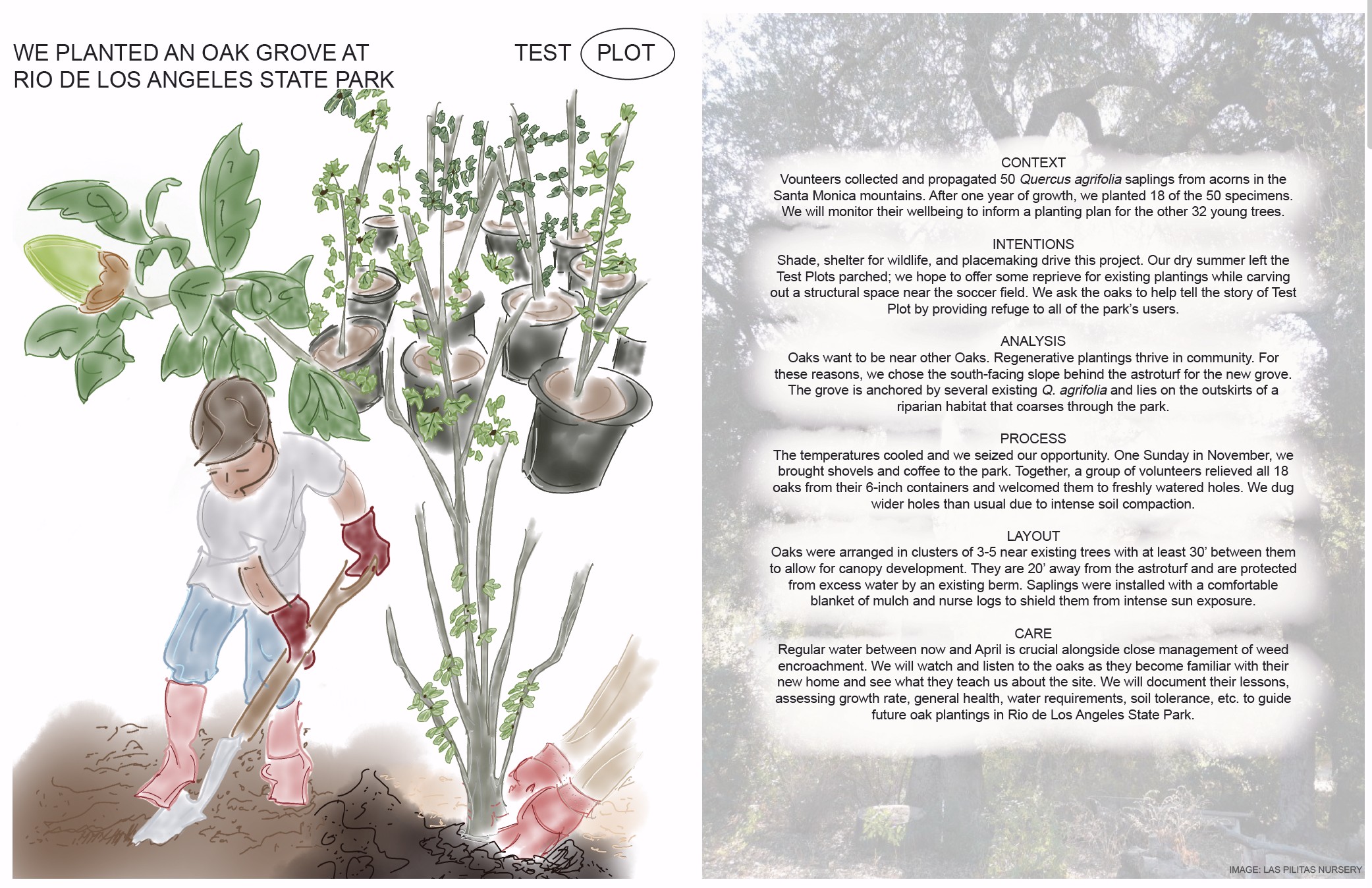

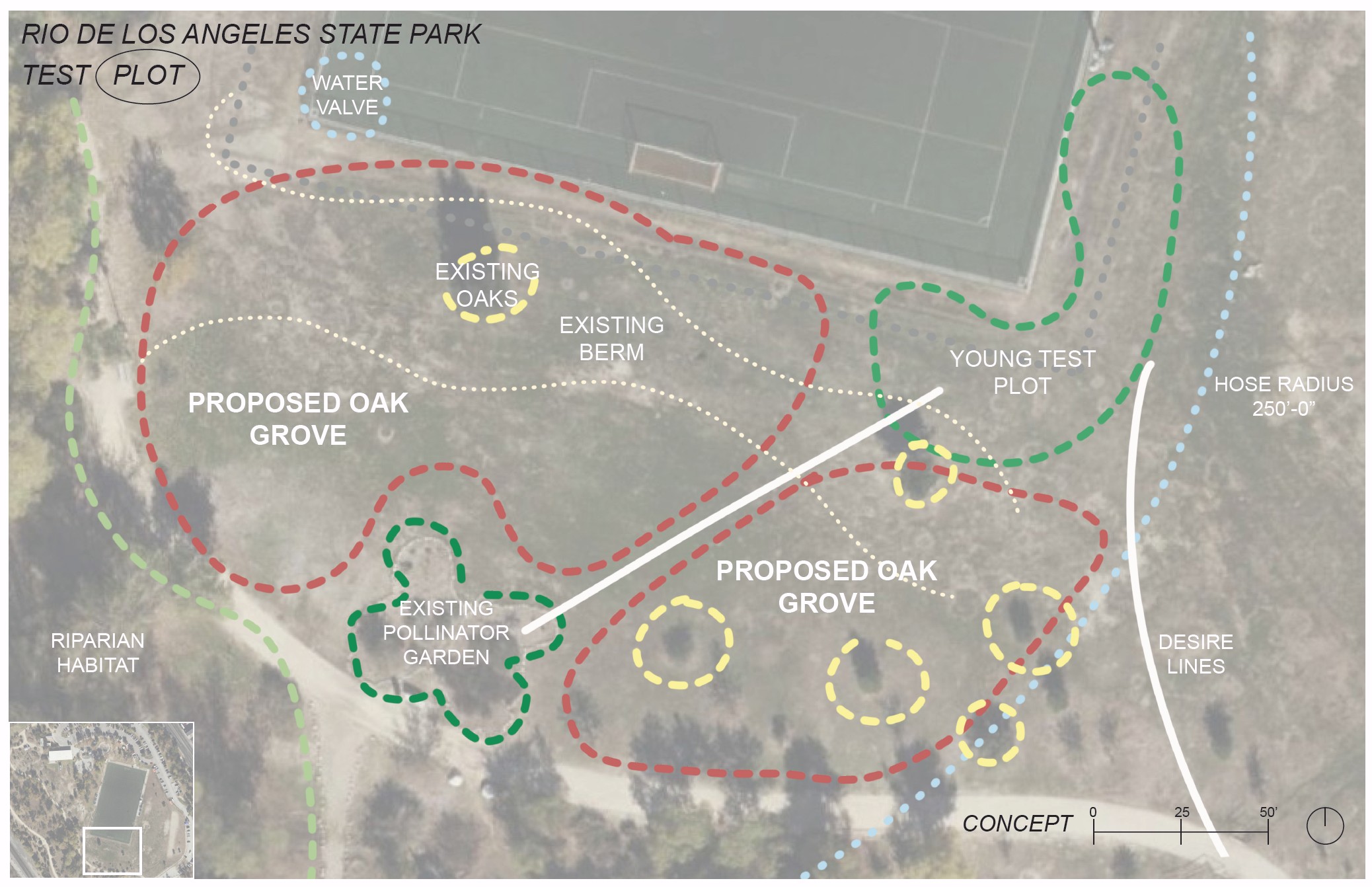
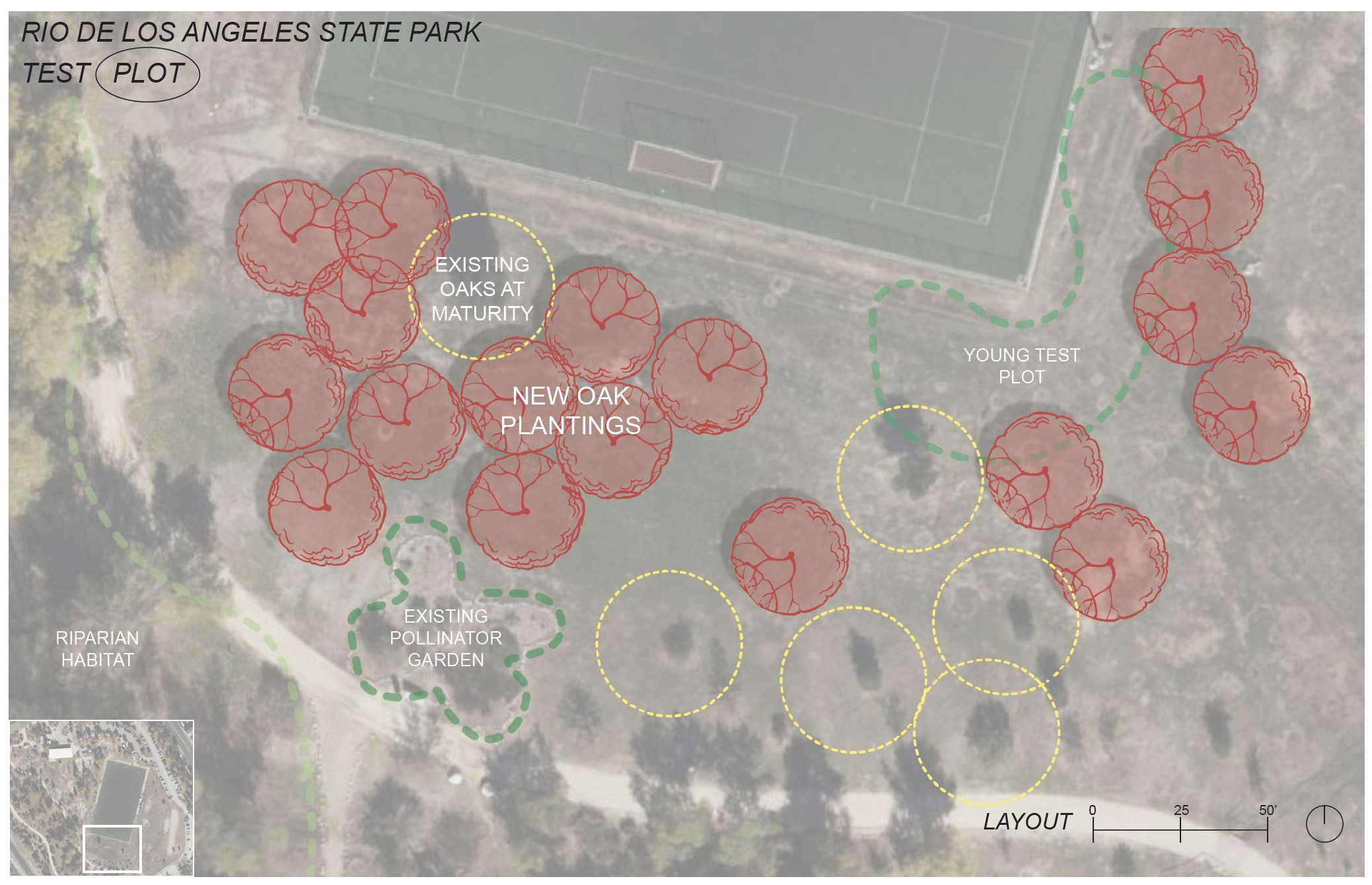
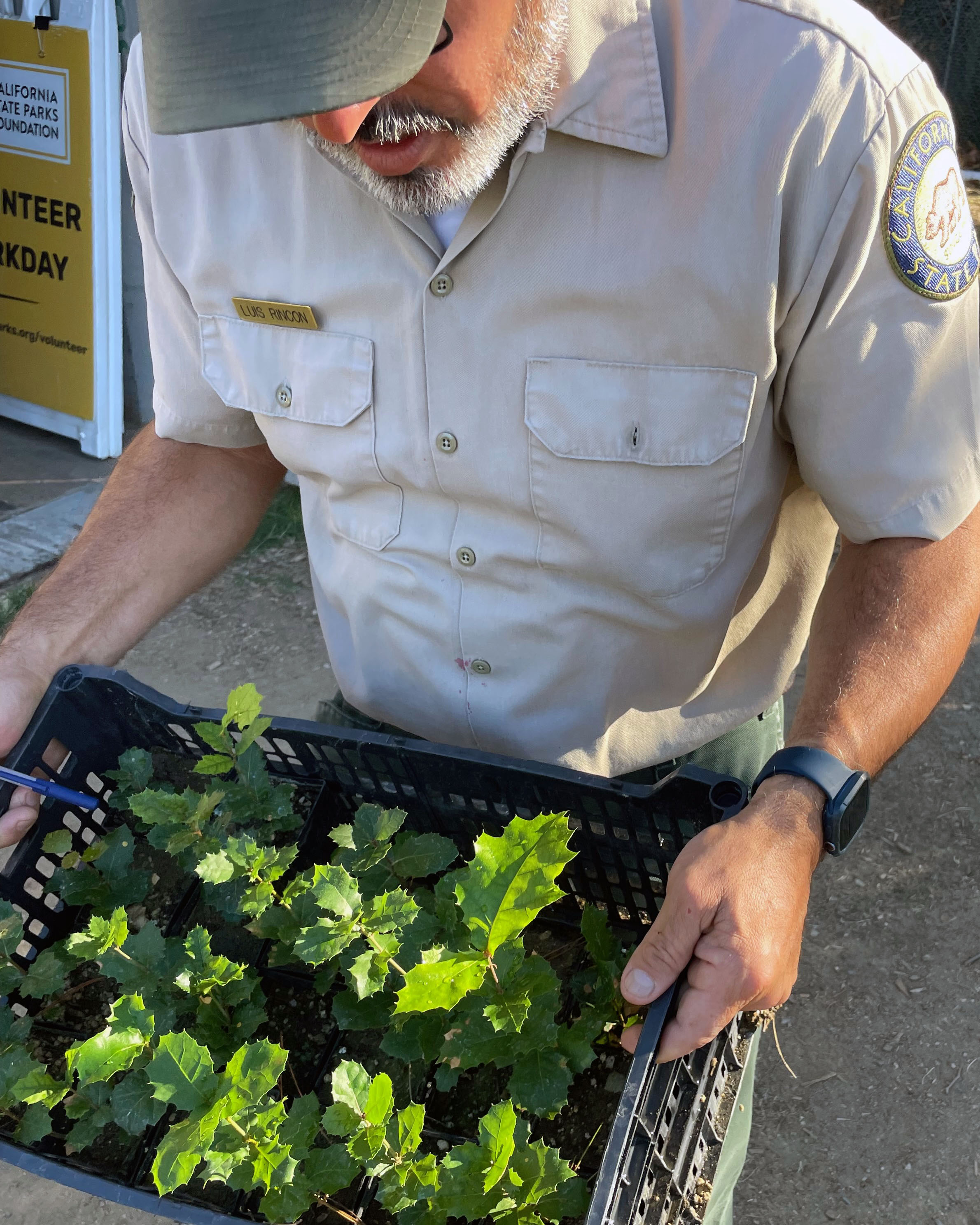
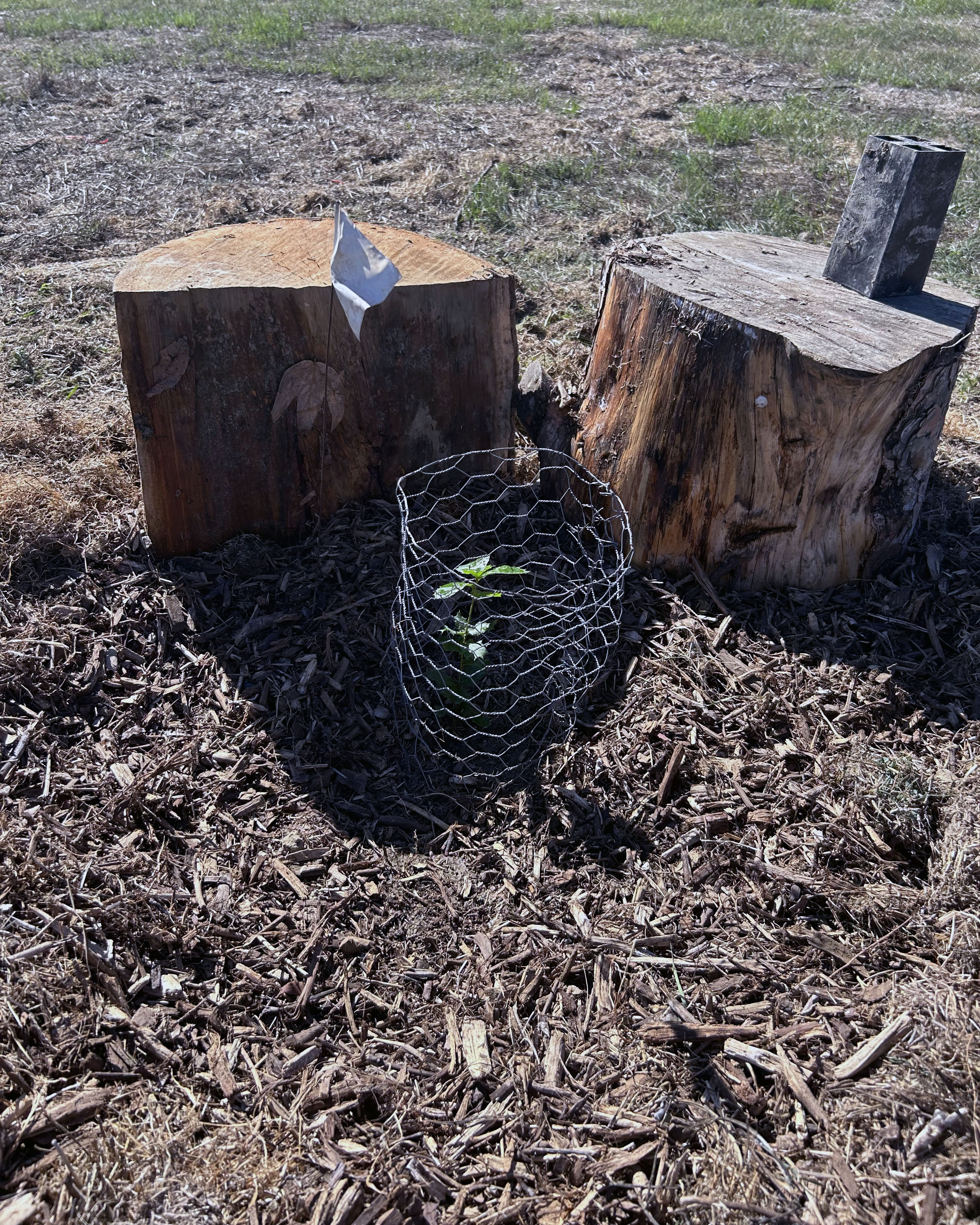
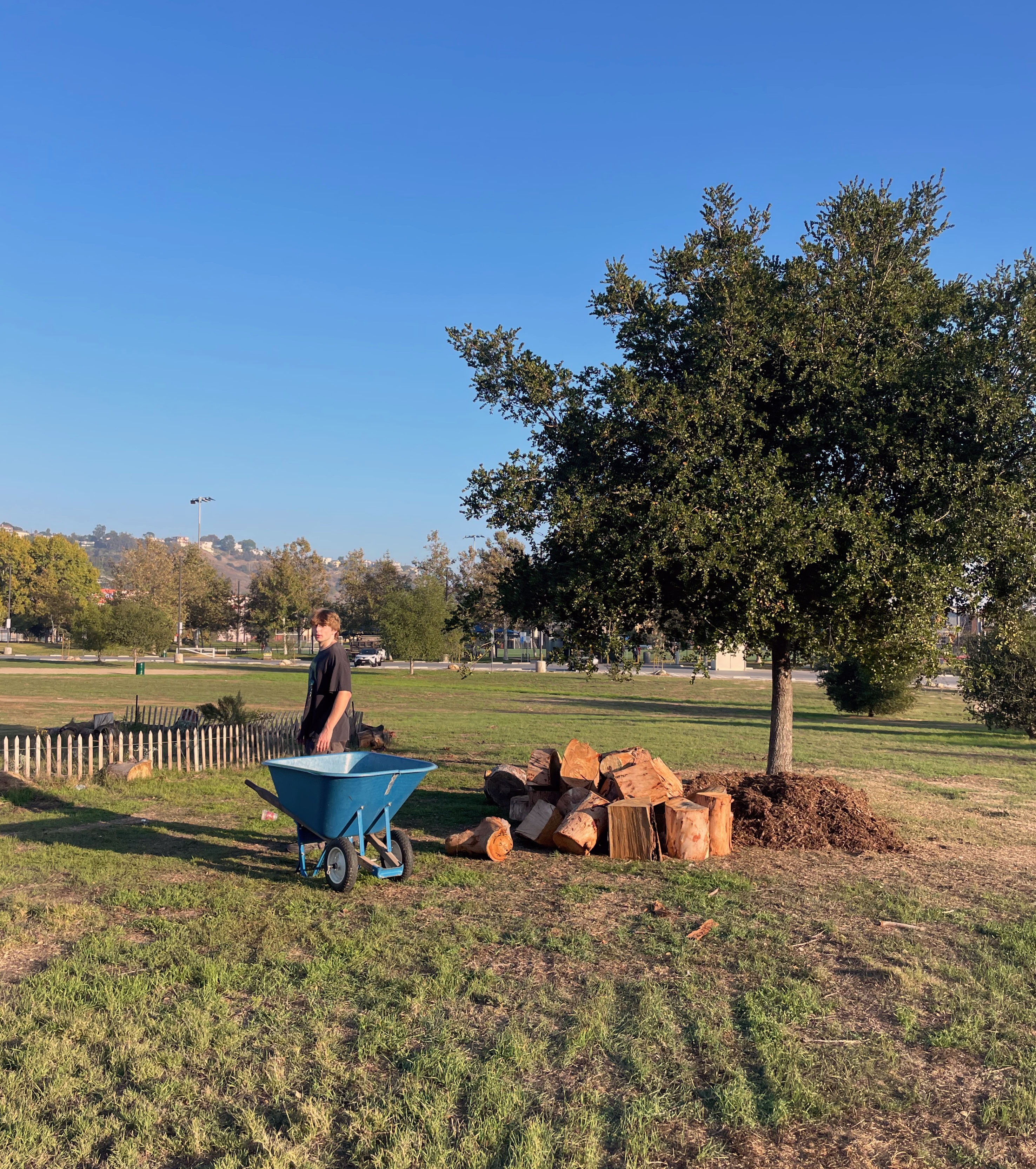

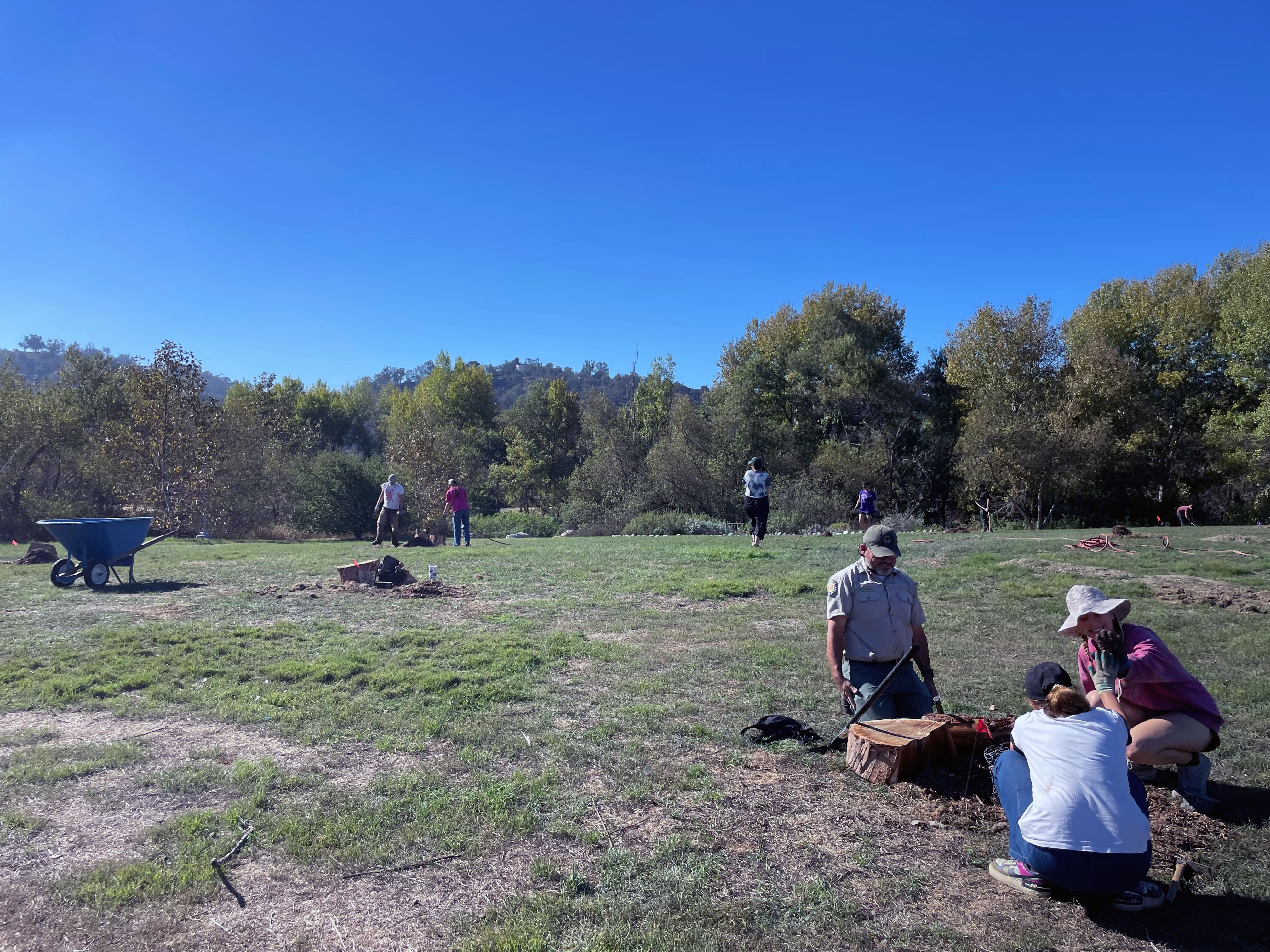
SITE SENSORY EVENT, AN ORAL HISTORY
Rainbow Canyon Test Plot
DATE: October 04 2025
During the process of introducing students to the canyon I led them on a few site sensory exercises. These ranged from basic meditation, that we call “Look and Listen”, to measuring exercises, like soil analysis. These were fun, relaxing, and enlightening, so we decided we should share these with the community. In the end, the students conceived of, and prepared, twelve site sensory exercises. These were enacted on Saturday morning on October 4th, 2025 with a great group of volunteers, including a contingent of high school students brought by Community Nature Connection. In the morning, before everything started, a local young birder from the neighborhood, Surya, led a well attended birdwatching walk. The day was sweet and beautiful. Everyone was a bit surprised how much they enjoyed it. After spending most days working in the canyon, it was a treat to spend time just tuning into the place.
— Alexander Robinson
I did a 2:30 hour bird walk through the canyon while practicing deep listening through birding. One thing I noticed was around the end people were more quiet and we found more birds. This shows how listening and focusing on the environment can help you notice more. I also showed the importance of citizen science by submitting a list of the birds seen to a database.
— Surya Jeevanjee
I helped people discover their cognitive preferences with sun versus shade measuring. I expected people to have a preference towards the heat, but it was largely voted for the shaded area as it gave a more calming sensation. I expected to not be able to form a general analysis of temperature preferences, but I noticed while repeating in other spots, there would be a general shift in how long people would want to stay in a shaded v. sunny spot, which was interesting. People seem to prefer a counter temperature to an environment they were raised in (So-Cal heat).
— Alejandro Vasquez
We practiced embracing imperfection and letting go by making art from dried plants, then intentionally destroying it afterward. I went in expecting most participants to make simple circles or grids with the dried plants they collected. Instead, they gravitated toward sculptural pieces shaped by intuition and background. The architects worked systematically: they started at the center, built a boundary, then stacked, and ended up with something like a primitive hut. The kids were bolder and more instinctive, hauling big logs and leaning them together to “build” what they pictured: a large house or a bridge. High school and college students were playful but liked to test the rules, mostly gathering leaves in different colors and arranging the patterns suggested by the reference images. It was also funny watching kids haul logs taller than they were. Lynden grabbed two huge logs and decided each one, on its own, was his artwork. Watching how personal experience steered each approach, and how many different outcomes emerged, was the best part.
— Anh Bui
The event we have is exactly what I was expecting, it was fun, engaging and it’s nice to see how much attention this site receives from its surrounding community. We met Lynden, an interesting 9th grader from a neighboring high school, he sure have a lot of opinions on things and often be the funniest one in our group.
— Jianjun Xu
The sensory activity was a guided blindfolded walk where participants used hearing, smell, touch, and sight to experience the site. I expected the plan was to have them walk through the site four times, each time focusing on one sense, but after the first group, I found it worked better when they stayed in front of the same object and used each sense on the same project. What interested me most was how different relationships changed the experience. Couples and parents with kids moved smoothly. Friends, on the other hand, kept bumping into things, but they were laughing the whole time and having fun. Everyone said they really enjoyed the activity also for me. At first, it felt strange to only rely on other senses, but once I got used to it, it became really fun. We all felt that everything around us seemed closer and more alive than usual.
— Jianye Wang
The Collaborative Atmosphere Collage slowly came to life as people walked through Rainbow Canyon, pausing to sketch places that felt meaningful to them. Each drawing was added to a line stretched between trees, turning into a quiet collection of impressions shared across the site. When sunlight came through the canyon and touched the papers, it felt like the drawings became part of the landscape. That moment — when everyone stood together, looking at what had been created, with the sketches moving gently in the wind — felt like a small exhibition, briefly held in the land itself.
— Jiya Yuan
I helped people create a contour and flow mapping of the test plot. During my activity, the participants were engaged to a surprising extent. They worked fairly hard to map out the creek's contours, too, which I didn't expect to happen and once I explained things to the participants, they were autonomous. I believe the activity thrives in its simplicity and the immediate tactile and visual feedback it produces. I could see participants holding discussion as they methodically worked sideways through the canyon.
— Josiah Hickman
Stream study was conducted where different participants helped measure depth and width at 3 different points in one area, proceeded by the following group conducting the same activity 10 ft away from the previous spot. Following the measurement participants also gave notes on anything they noticed. One observation that was interesting was the amount of litter that is imbedded into the stream, from bottles to shoe inserts. There was also evidence of asphalt which had some participants questioning if there used to be a road in that segment or if it was runoff from rainfall. Participants had fun and were very invested in the exercise. The exercise felt like it was more efficient and enjoyable when people worked in pairs rather than alone. The best part was seeing how people found out about the event through so many different channels and seeing people from different backgrounds come together for this activity.
— Navid Rodd
My main site sensory activity was tree hugging, while the secondary one was the feedback tree. I was a bit nervous going into the event because I wasn’t sure if people would be highly engaged. There were some kinks in the activity when Richard & I tested it the second time we visited Rainbow Canyon, and then we tested it again and had more edits. I was thankful we were able to work together. We had a high school freshman participate, and his personality and engagement were so fun! I considered Richard and I splitting off to run the exercise with different people separately, but we decided to stay together in groups of three. This enhanced the tree-hugging experience because three people hugged one tree at the same time; as they experienced the comfort (or discomfort) from hugging the tree, there was a greater community aspect in doing it together. I laughed a lot, and it was interesting seeing which tree each person chose at the end that they identified with the most comfort with a circle of red string.
— Sara Eyassu
I instructed people on how to complete 15-minute "look and listen" sessions lying down. Many told me that they felt relaxed and took notice of how quiet the canyon was. One thing that surprised me was how many people said that the contours of the canyon felt good for their back pain. A land stewardess shared that she spends so much time taking care of the land, she never stopped to consider how the land could take care of her.
— Zoelli Ortiz
I ran a soil analysis station at saturday’s workshop, in which i encouraged guests to conduct both pH and qualitative texture tests. most participants were surprised to learn that the soil pH was consistent across the site, despite variation in soil sample colors, textures, or locations!
— Haleluya Wondwosen
I worked with Hal. More people joined the soil activity because it was simple and fun to test the soil. The litter mapping started slowly, but after some time, people joined in. The kids were more interested in storytelling and discovery than in cleanup. They preferred to talk and act things out rather than write. I had to ask them again and again to try. One kid named Unni found an old tyre laying around and started making up stories about it. The children liked talking and telling stories more than writing or picking up trash. The adults, on the other hand, were more comfortable participating in both mapping and writing. They engaged once they understood the purpose of the activity. Overall, the litter mapping exercise worked, but it needs to be simpler and more fun — maybe more talking or drawing instead of writing.
— Sai Ravikumar
Walking through the canyon blindfolded meant I had to completely trust Sarah. She guided my hand up towards things to touch and handed me things to smell. I became aware of the gentle slope of the canyon floor, noting I had to pick up my feet more! I liked how the small groups of people chatting became anchors that helped me orient myself. Despite being blindfolded, it felt carefree, like a return to childhood.
— Jen Toy
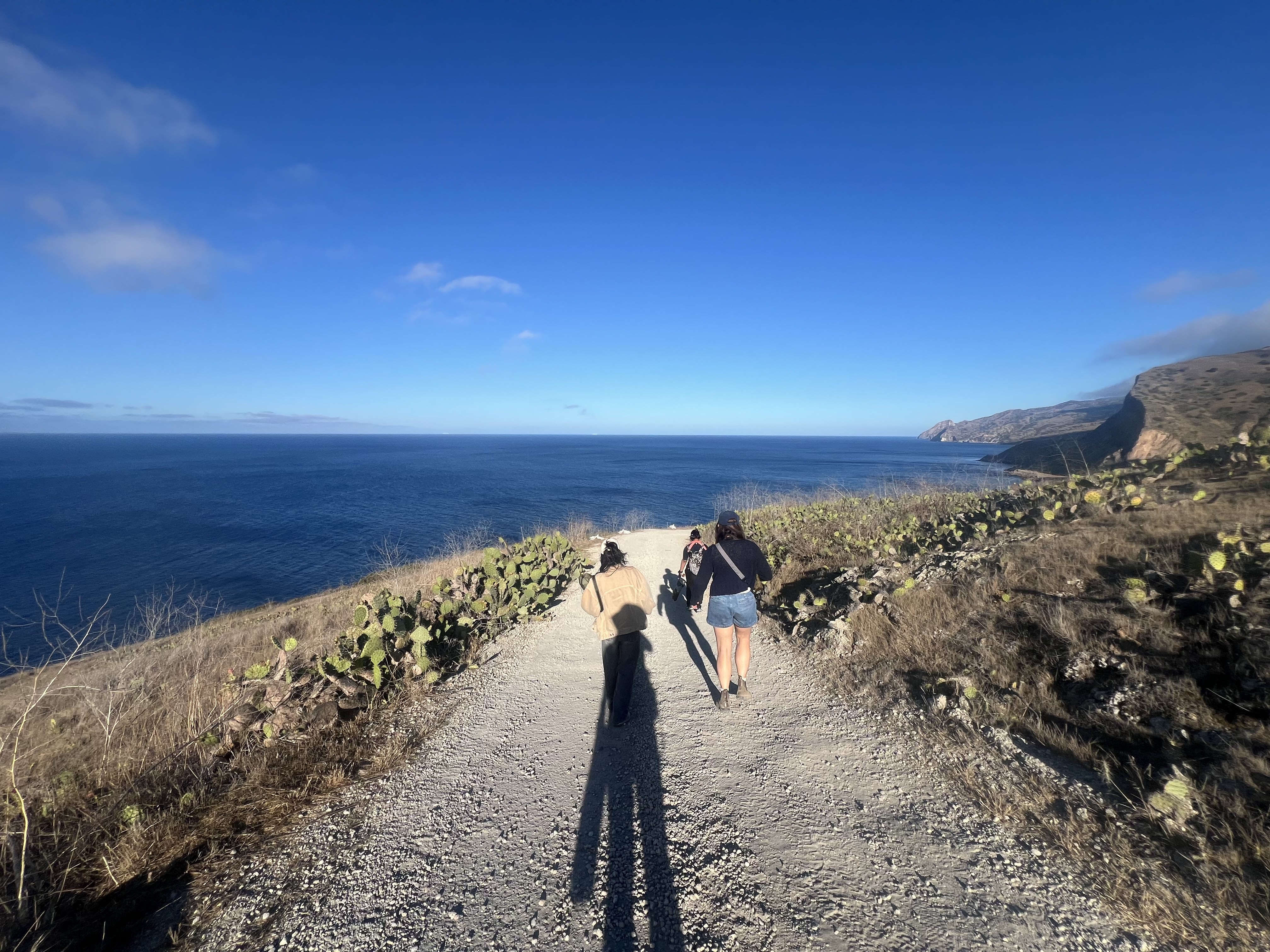
UNDER PRESSURE
Catalina Island Test Plot
By: Alex Robinson
DATE: September 10 2025
Traveling to Catalina Island, or nearly any of the islands off the coast of Southern California, can be an exercise in time travel. For a resident of the mainland bight, it is a multi-threaded journey. Yes, time goes back, rhythms slow, but time also jumps ahead and sideways. The day I visited the Test Plot at the Wrigley Marine Science Center, had a touch of foreshadowing. After our indeterminably long and late hot summer, I enjoyed what everyone agreed, was the first day of Fall, weeks ahead of the mainland.
Talks of cutting back and layoffs were in the air. In the wake of our president’s agenda, research money was drying up and USC was looking to cut research-related staff on the island, many of whom rely on their job to maintain residence on an island mostly owned by either the Catalina Company or Conservancy.
Due to a mild but persistent drought, the plants in this Test Plot have subsisted only by rain and water harvested in rain barrels around the campus. While the channel concentrates moisture, it also bakes, sheltered from coastal breezes by the surrounding dorms. The drought has reduced forage on the island, inducing (introduced) deer and the native squirrels especially to munch the plants. The delicious ones are “topiared” into the shape of their protective steel cages, if they are so lucky to have one.
After this year’s devastating fires, the fire department reassessed all building adjacent plantings. Now nearly all the plants we had planted were “trespassing.” If they had their way they would clear all vegetation within a 100 feet of all structures.
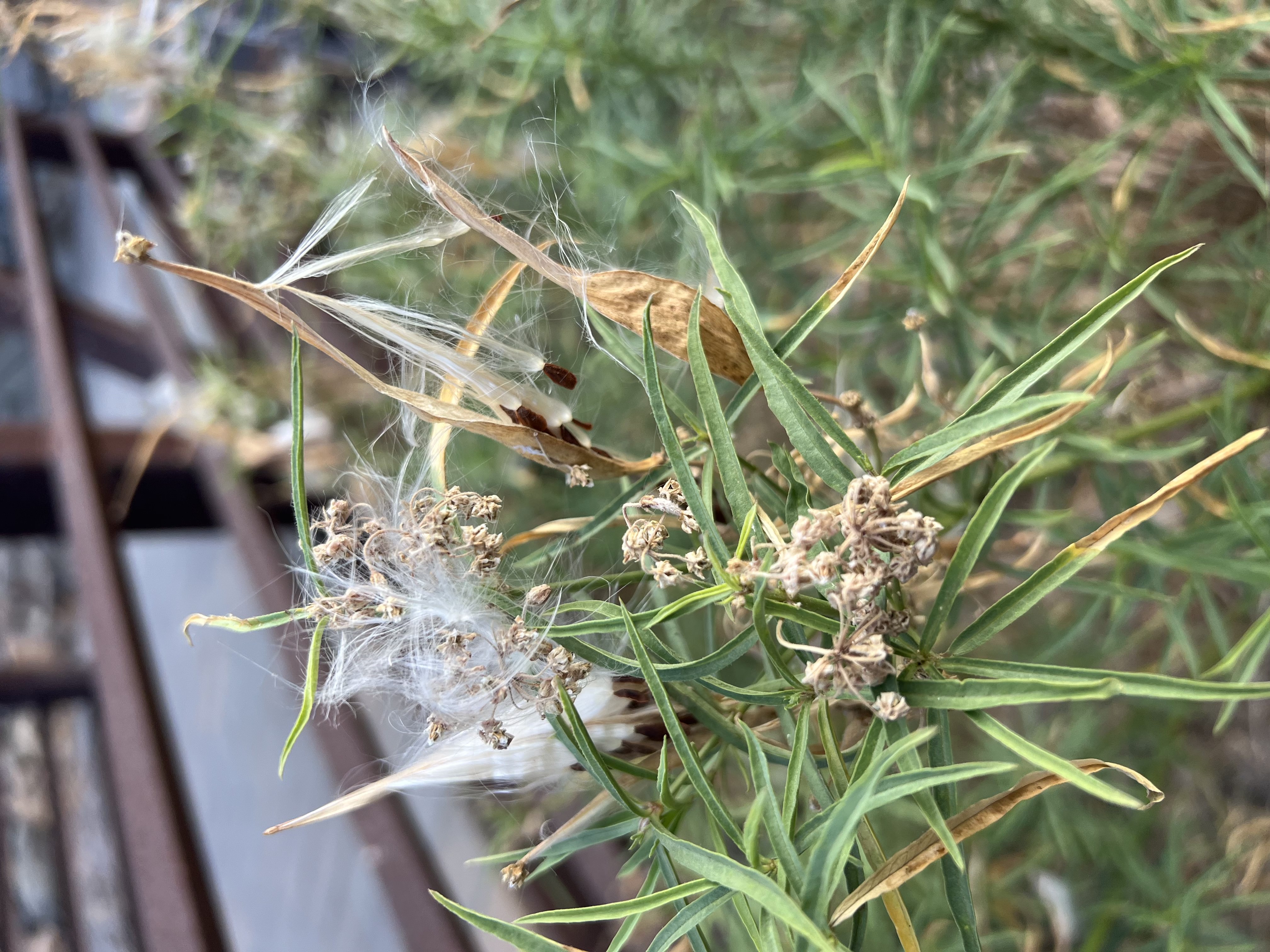
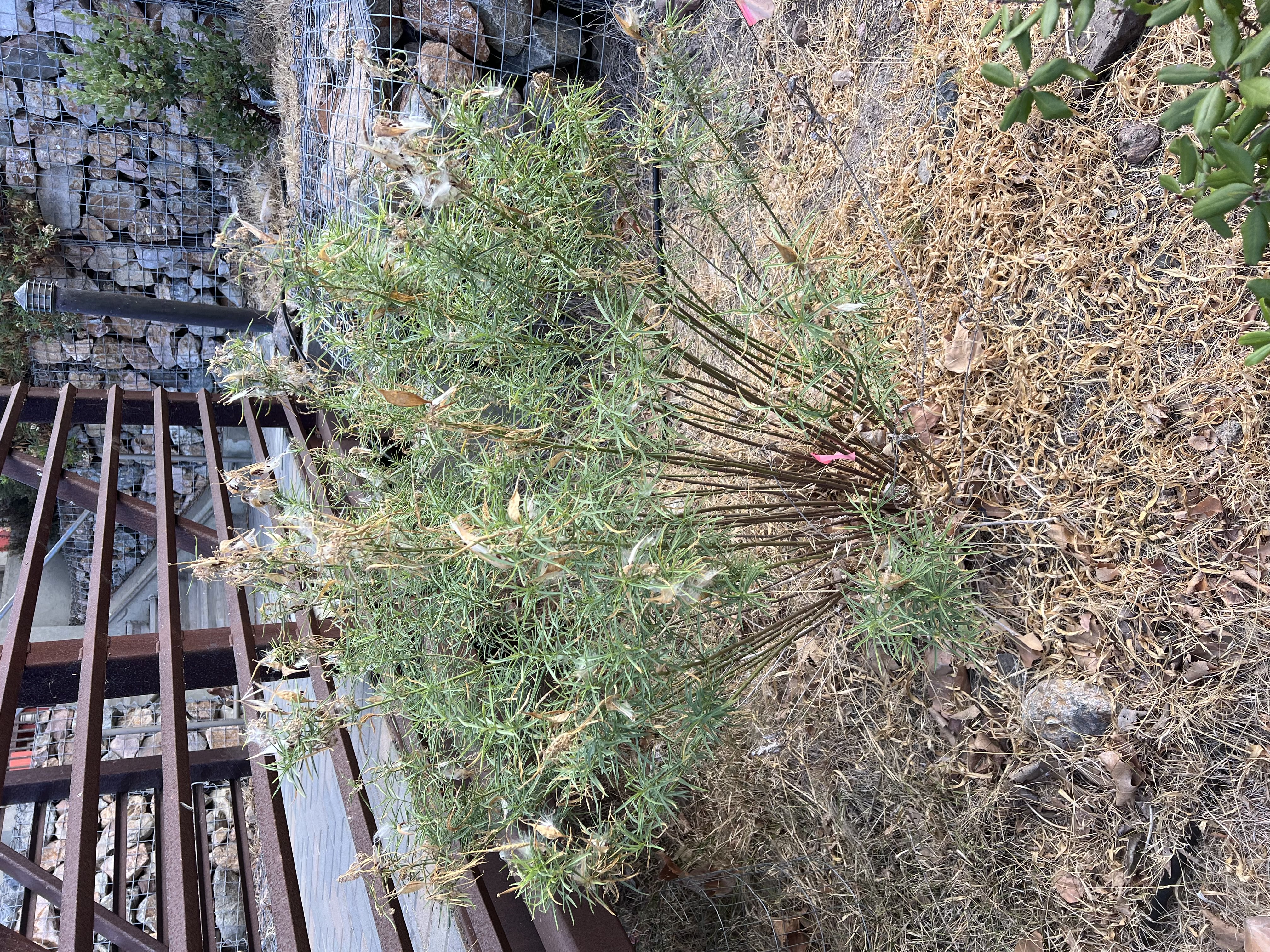
As I conducted my inventory, I could see and feel the pressures on the plot that its steward had skillfully been deflecting. As many islands are, Catalina is small, isolated, and exposed; it is simultaneously a place apart and precariously sensitive to ecological and political turbulence. Yet, thanks to her determined care, the plants are hanging in there and even thriving. The native milkweed has spread out triumphantly, shimmering in the sunlight, and seeding itself. The Catalina Ironwood, my favorite, was both being munched and had flowered, even though its planting pit had required an electric spade to excavate. Mugwort and Tule, two water loving species, were happy behind the check dams, we assembled two years ago. Many small plants, ones you would expect to be the first to go, were hanging on: yarrows, buckwheats, and Yerba Buena. The Catalina Manzanita was making a surprising sprint to its tree form.
All in all, perhaps more than 85% of the plants had survived. Casualties included the ever lovely St Catherine’s Lace buckwheat and the dudleyas, that while alive, had been nibbled to nubs. (All the plants were donated by the Catalina Conservancy over the last two years.)
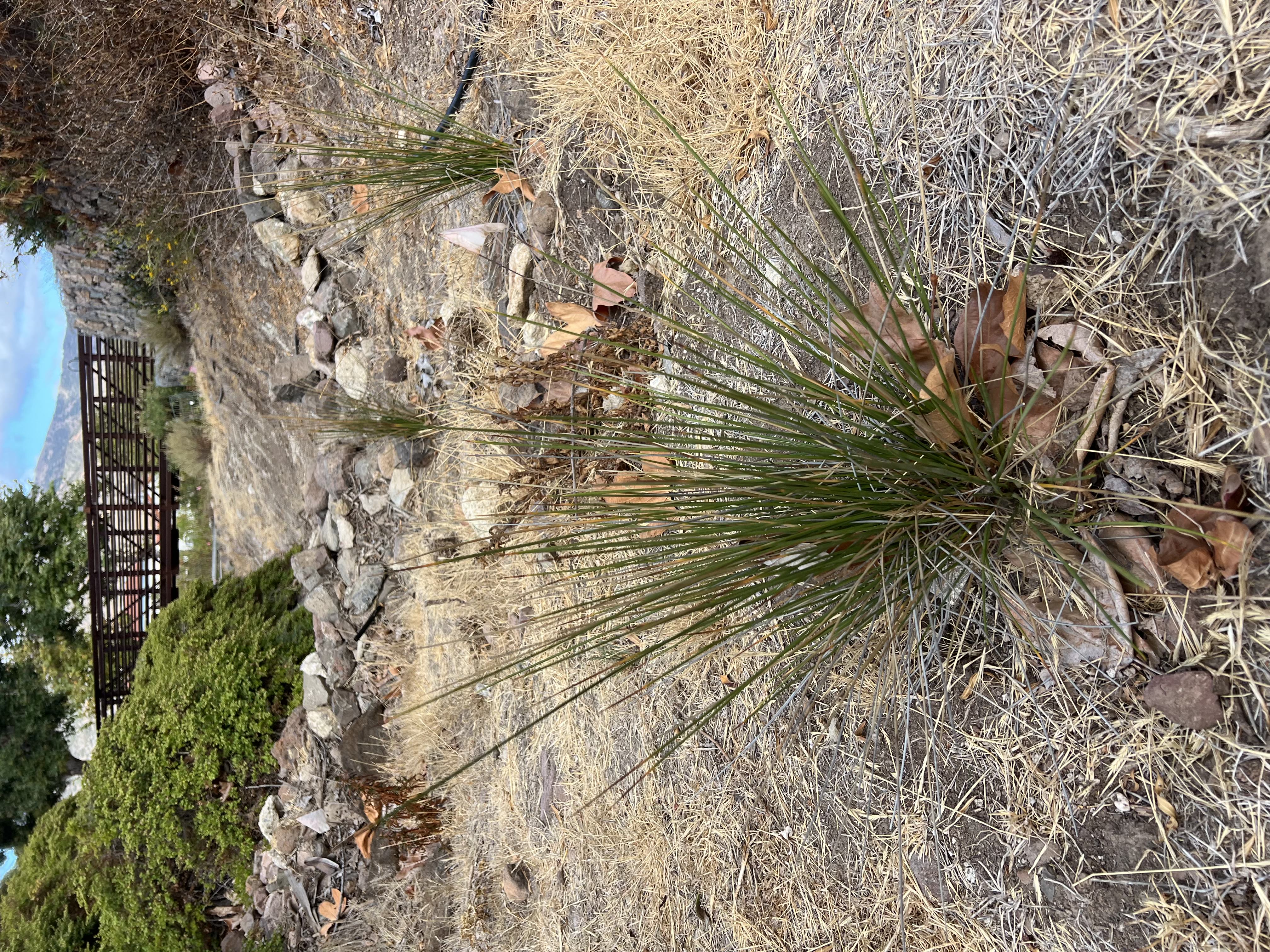
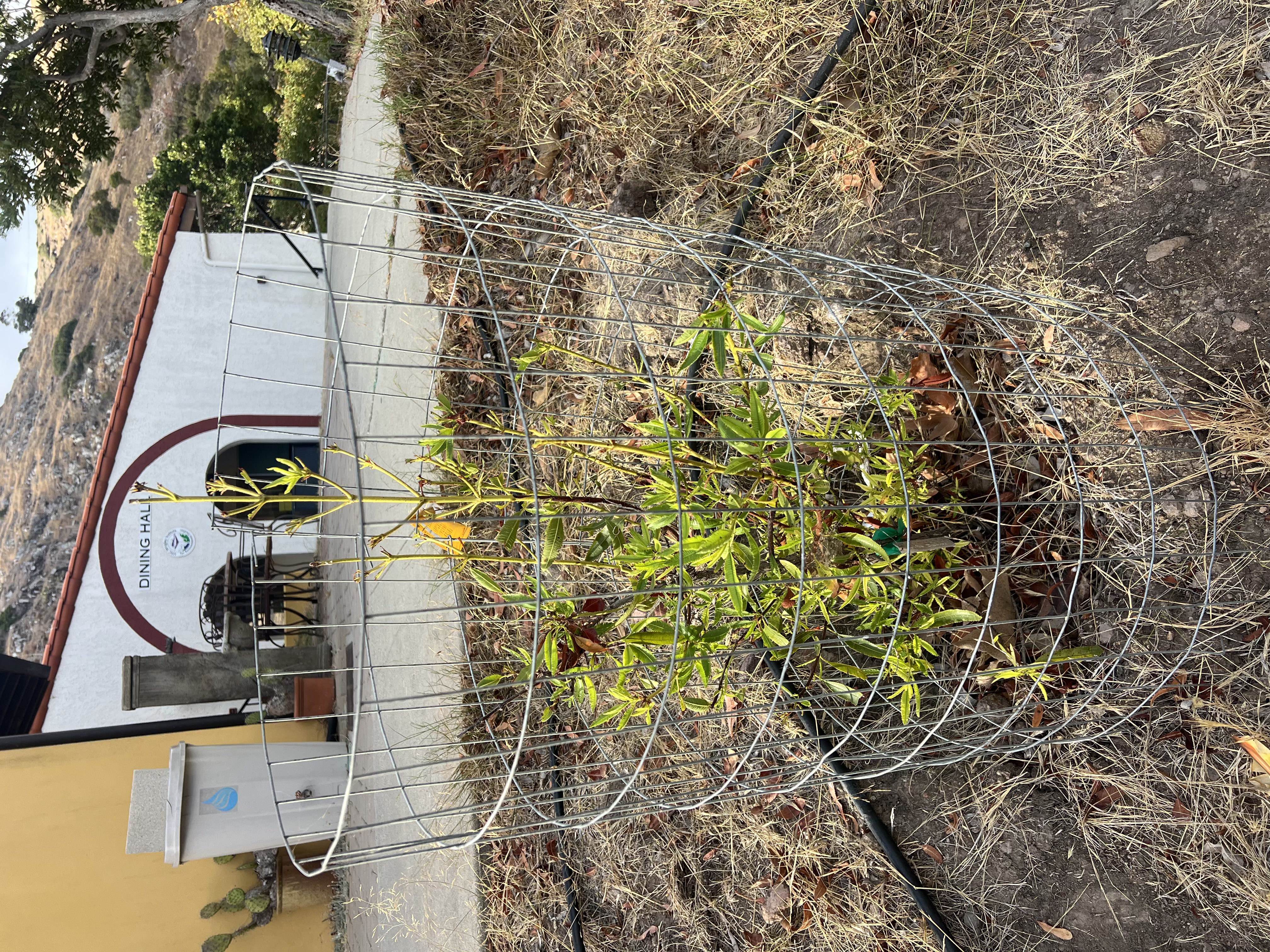
What is the future of this plot and its plants? Of this island and research station? More than most years, it is in flux.
Some of the pressures may subside. There is a plan to remove the deer from the island, that may actually be implemented; it would come with divisions and trauma, but would bring back biodiversity and radically improve all future restoration efforts.
Meanwhile, I wonder whether our island steward will survive the cuts. I worry for her and I worry for this plot. The whole situation speaks to how much persists by the constant care of steward(s). They are needed to manage the pressures, but here we can see limits, however complex. The fate of the plants and the people are precariously entangled, and particularly on this outpost. In ways they tell us how to care: when to care for each and when we must tackle the pressures themselves.
I finished my plant inventory and went down to jump in the water. Later I headed back to the mainland on the Miss Christi USC boat. A few weeks later I heard our local steward would be laid off.
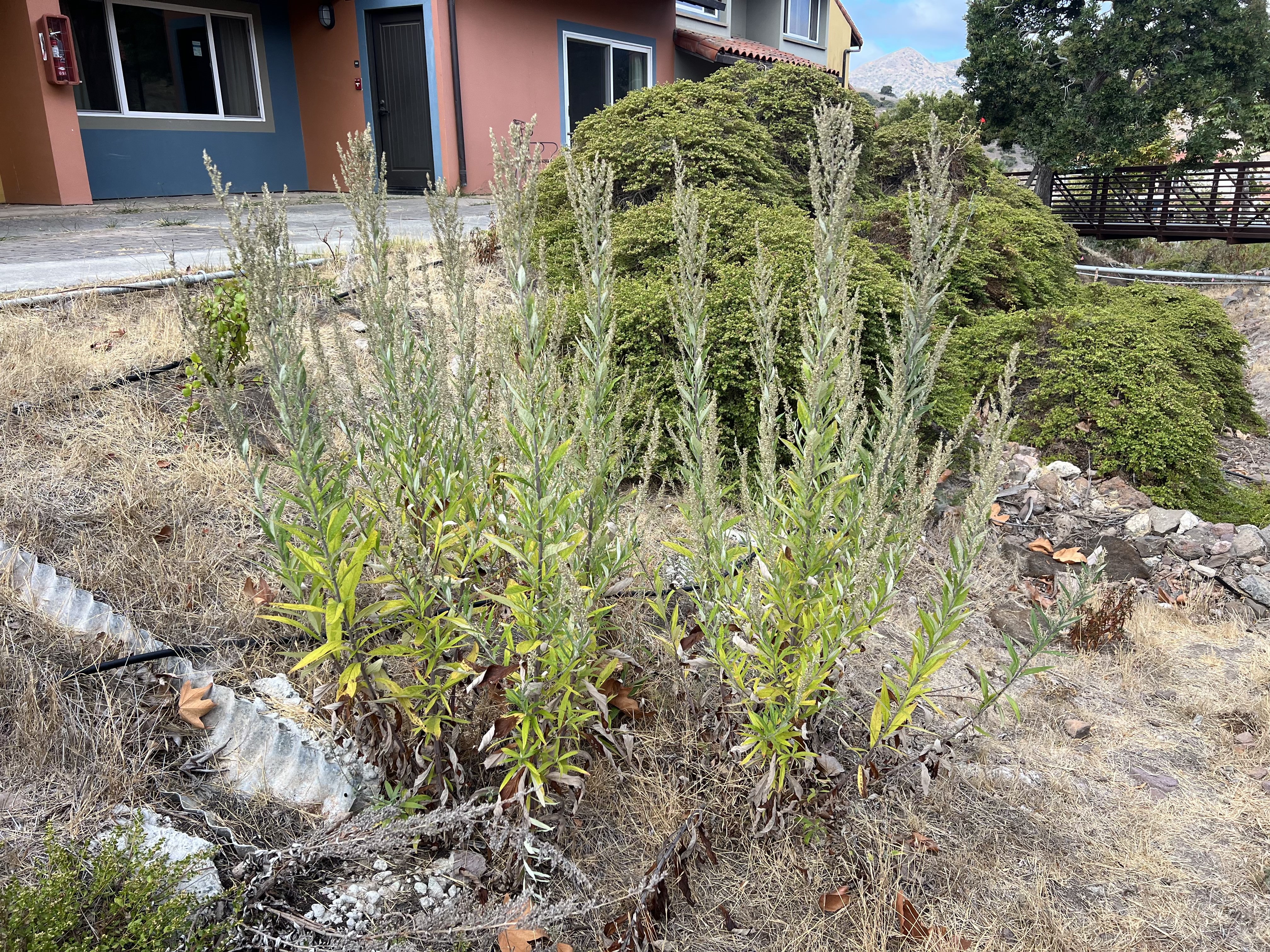
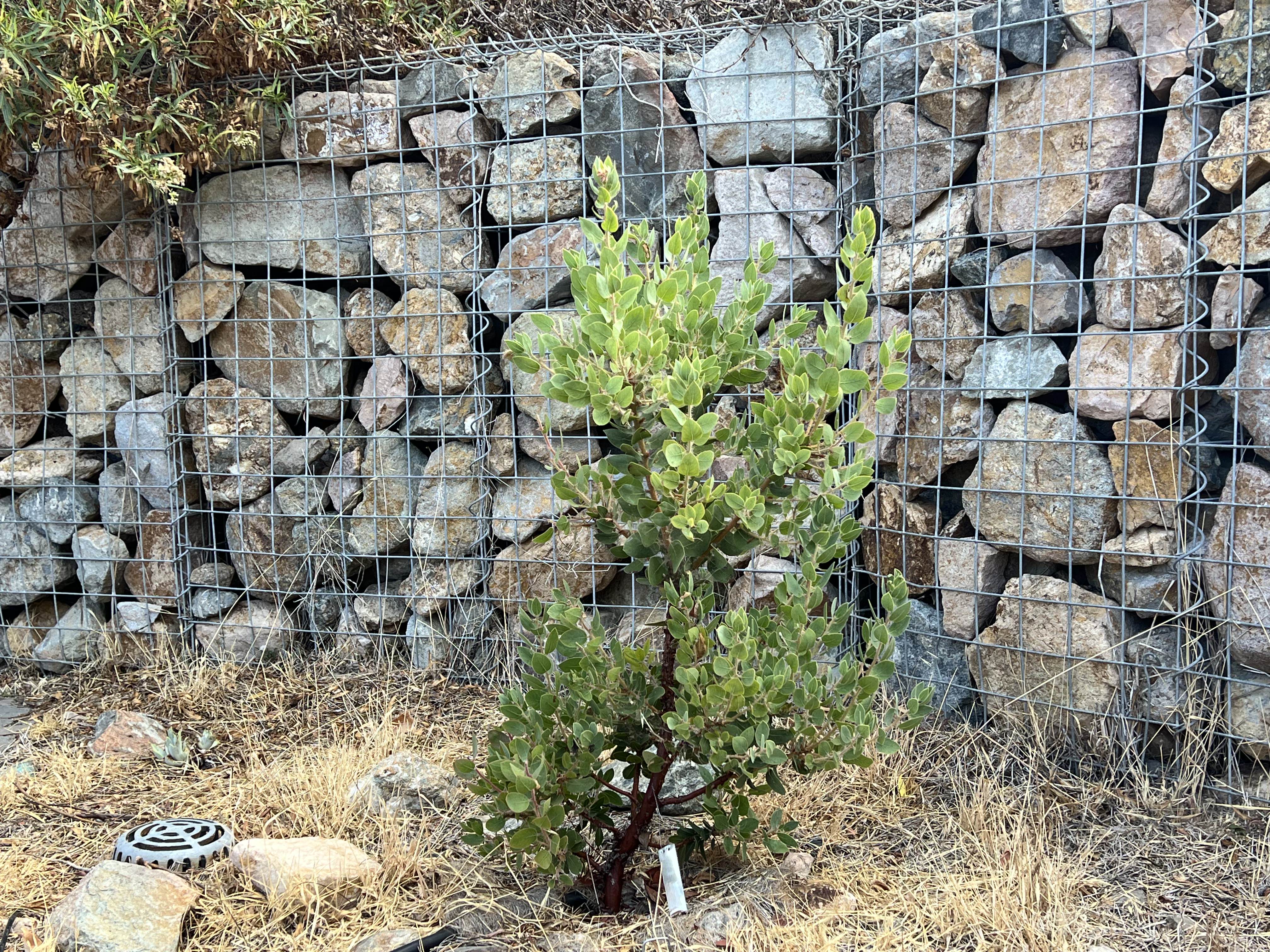
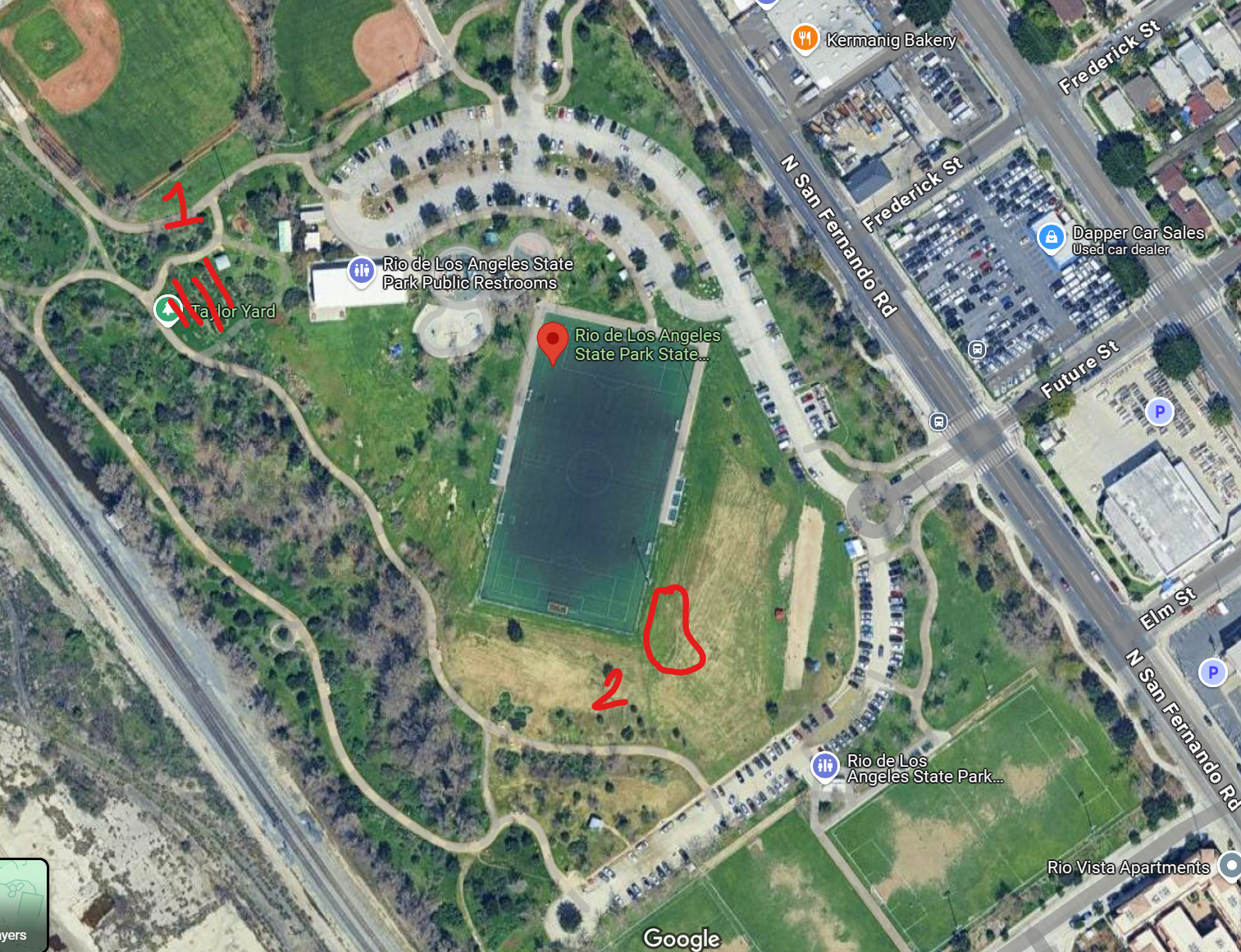
HEAVY HITTERS
Rio de Los Angeles Test Plot
By Tom Hurst
DATE: July 27 2025
Overview
On an overcast Sunday, I started an informal itinerary of successful species at the Rio de Los Angeles Test Plots. This living document is dubbed Heavy Hitters. We will maintain this evolving record of change at the site, focusing first on individuals before considering future categorization. I hope this document helps inform the ongoing restoration efforts at Rio de Los Angeles State Park. It is also fun to record the wellbeing of plants we care about.
Observations
Test Plot 1: The dense shrubs at Rio de Los Angeles thrive in the early summer sun. Hardy plants produce expectant buds, including Baccharis pilularis (Coyote Bush) and Isocoma menziesii (Coastal Goldenbush). Rabbits shuffle between them. The proud structure of Malosma laurina (Laurel Sumac) and Heteromeles arbutifola (Toyon) sets them apart from the crowd. Their branches shelter smaller species. The Plot is densely planted and there is a sense of communion. Change is also visible through death; many of the staggered plantings of Encelia californica (California Brittlebrush) failed while Monardella villosa (Coyote Mint) is dry and defeated.
Test Plot 2: At the younger Plot, Ceanothus thrysiflorus and Elymus condensatus (Giant Wildrye) break free of their gopher cages, their wire pants. Spent Salvia apiana (White Sage) stalks are relics of a warm Spring. In the throes of immaturity, Epilobium canum (California Fuschia) competes with Solidago californica (California Goldenrod). Their exchanges spill over the picket fence to a pile of harvested weeds. These weeds were cut low after the rain before they went to seed; their roots remain in place to minimize soil disturbance. This pile, we hope, provides habitat for insects. The ground feels cooler here than in Test Plot 1.
Landcare
- Water immature plants strategically through the summer without watering mature species unnecessarily.
- Cut back lone weeds (though few remain after successful volunteer outings).
- Evaluate the relative success of species to inform planting decisions for the fall.
- Prune struggling species in late summer to encourage regrowth.
- Keep mulch to an absolute minimum.
Brief Bio
Tom studies Landscape Architecture and works as a gardener. As a design student, he believes in the role of ecological regeneration to help rehabilitate public and private spaces. He is interested in design that makes the process of change visible, and the landscape legible. His voluntary work at Test Plot: Rio de Los Angeles is a manifestation of use, time, and connection. His favorite plant this month is Baccharis pilularis.
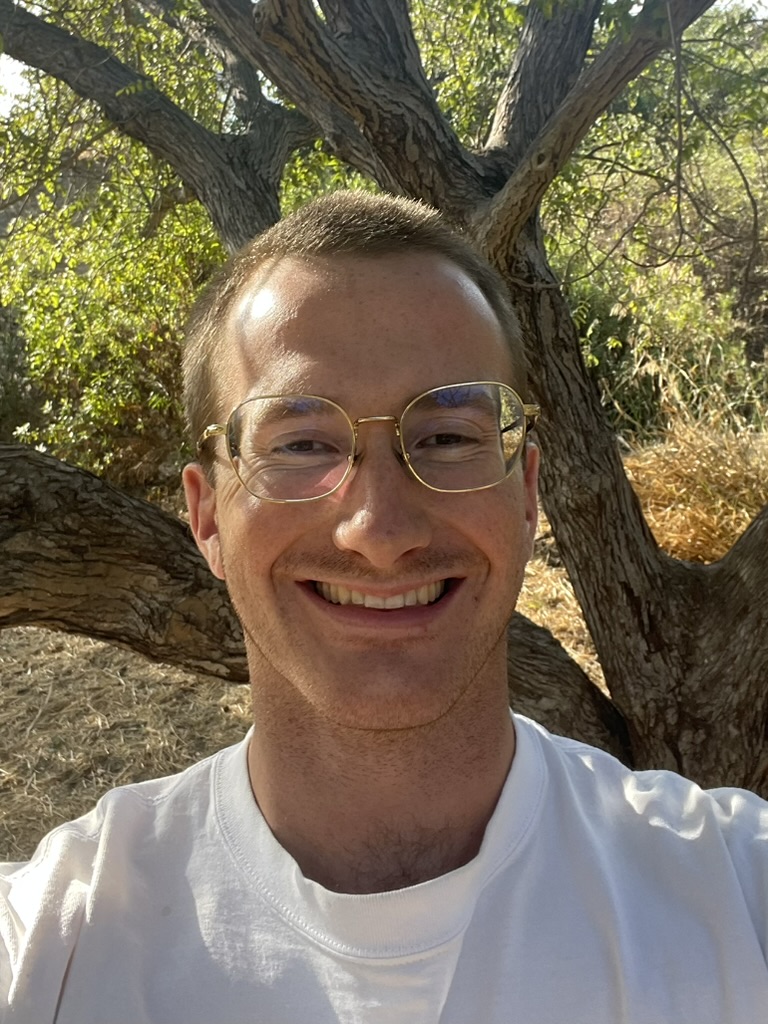
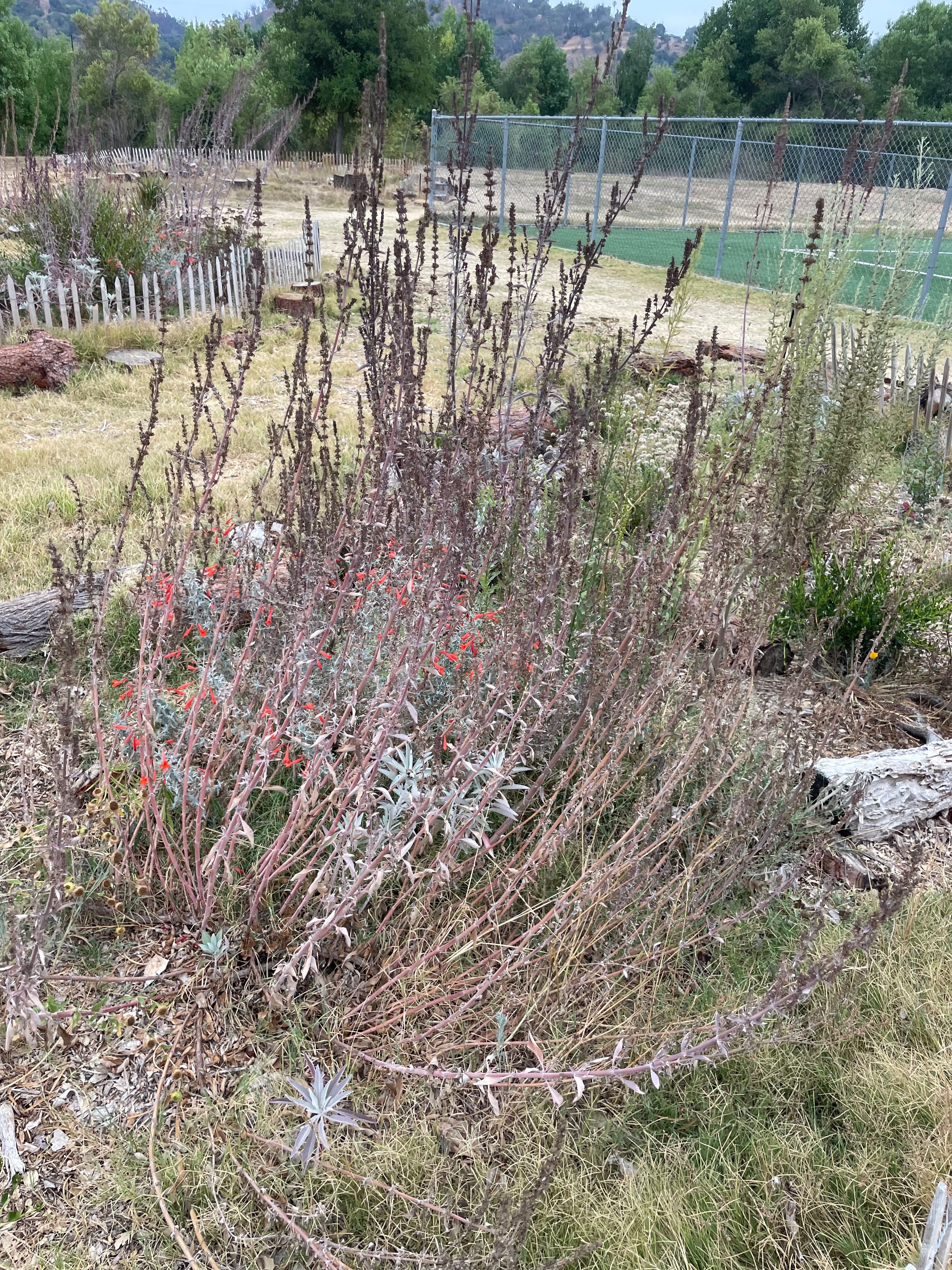
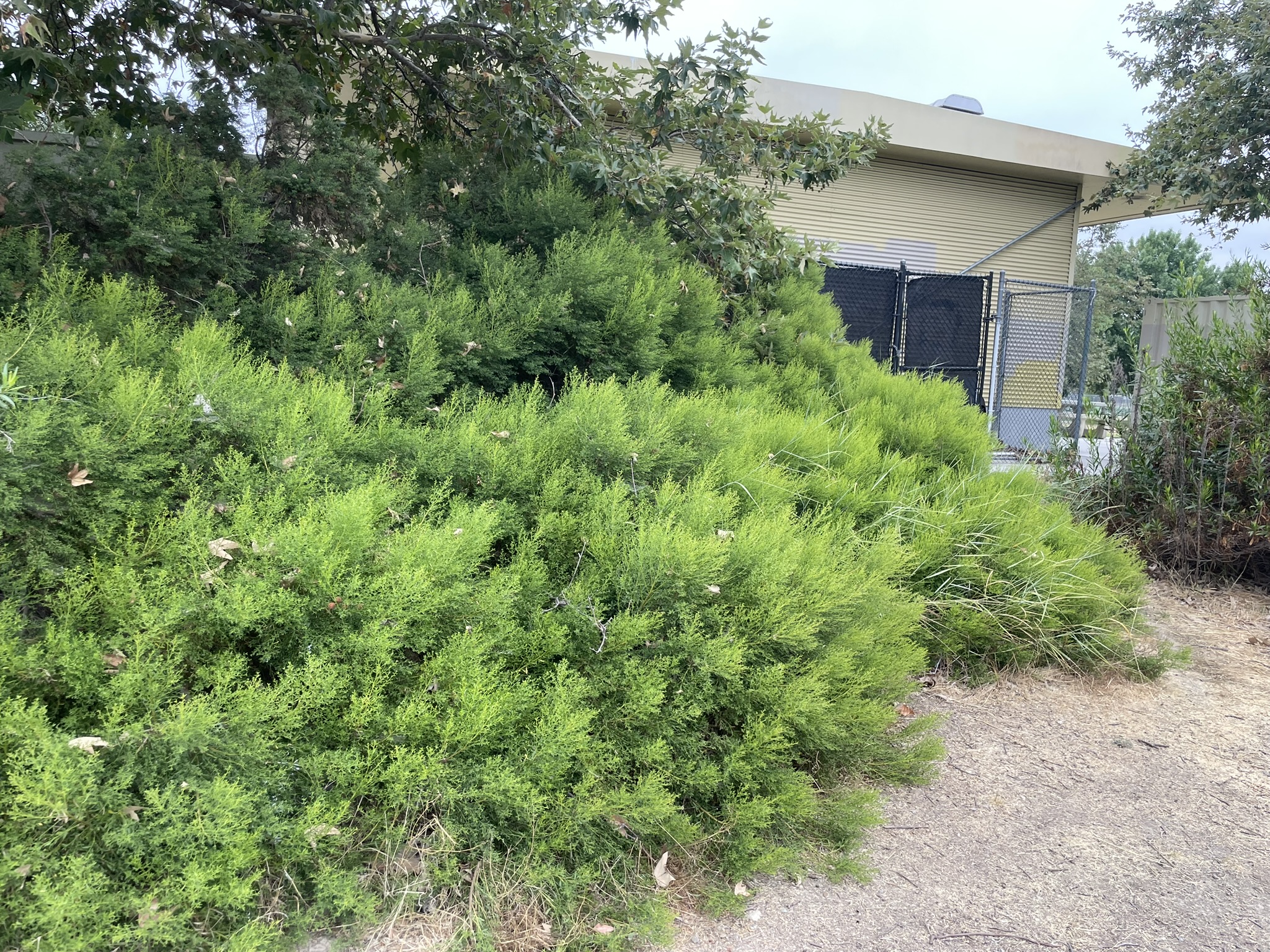
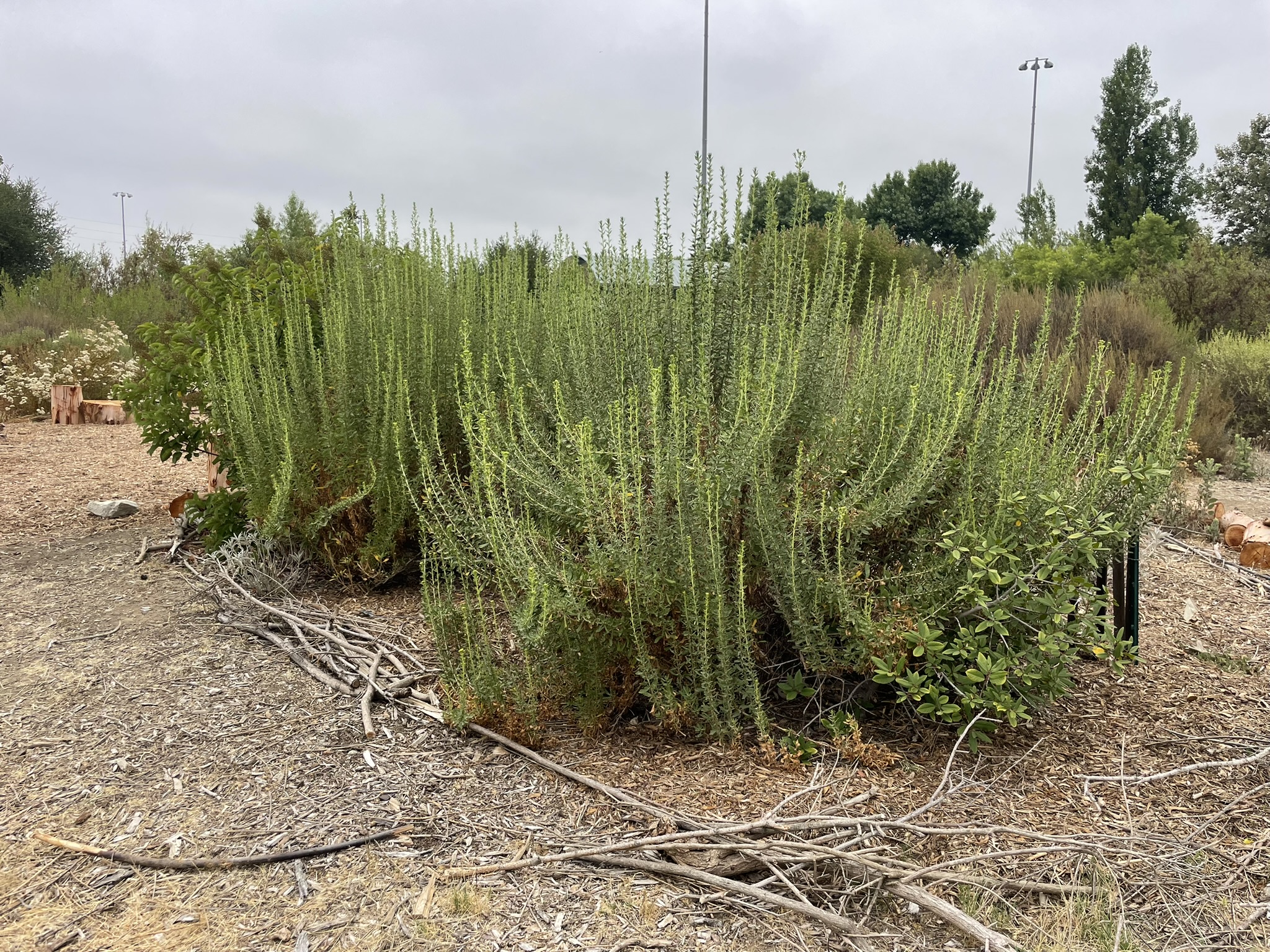
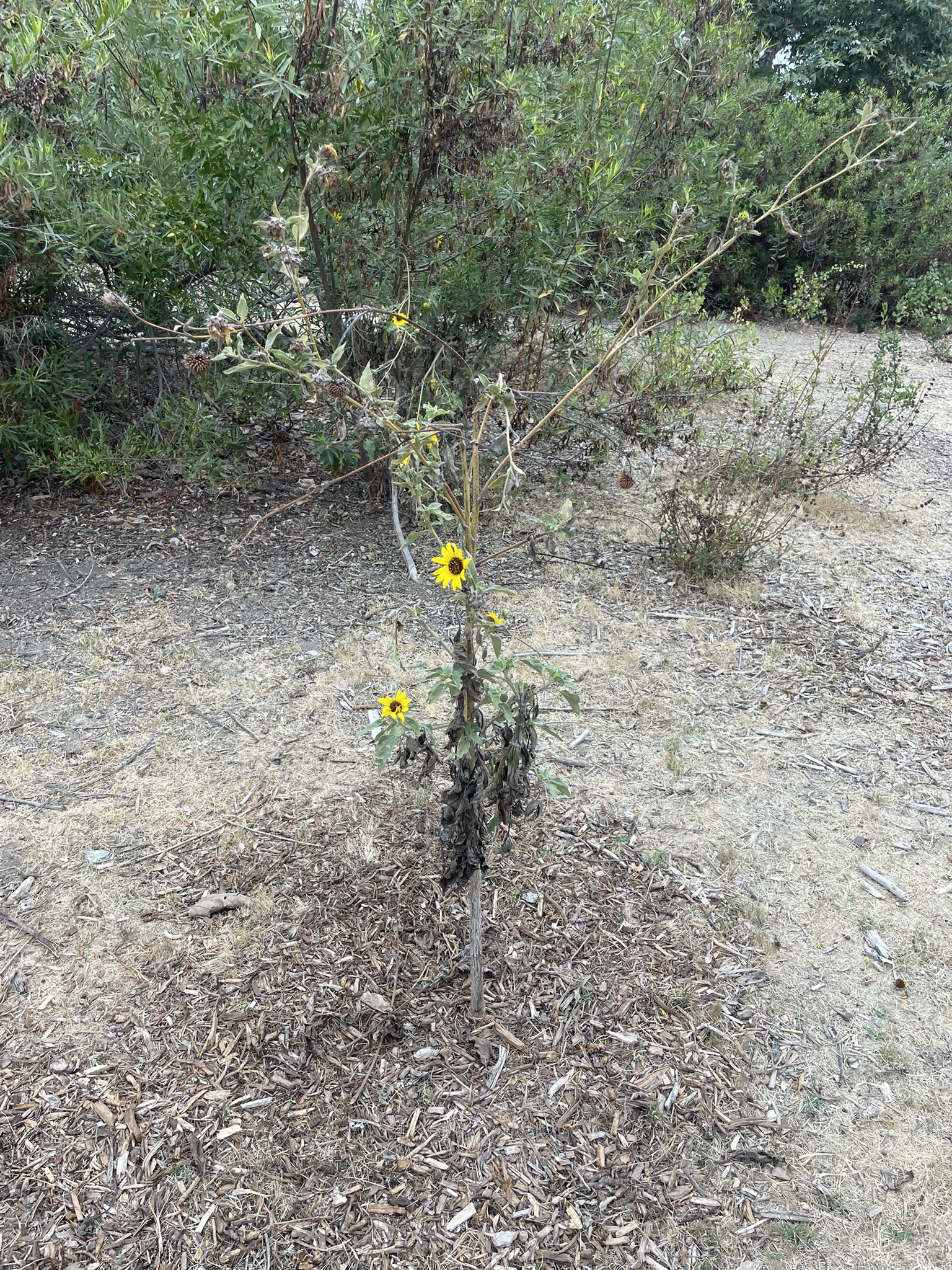
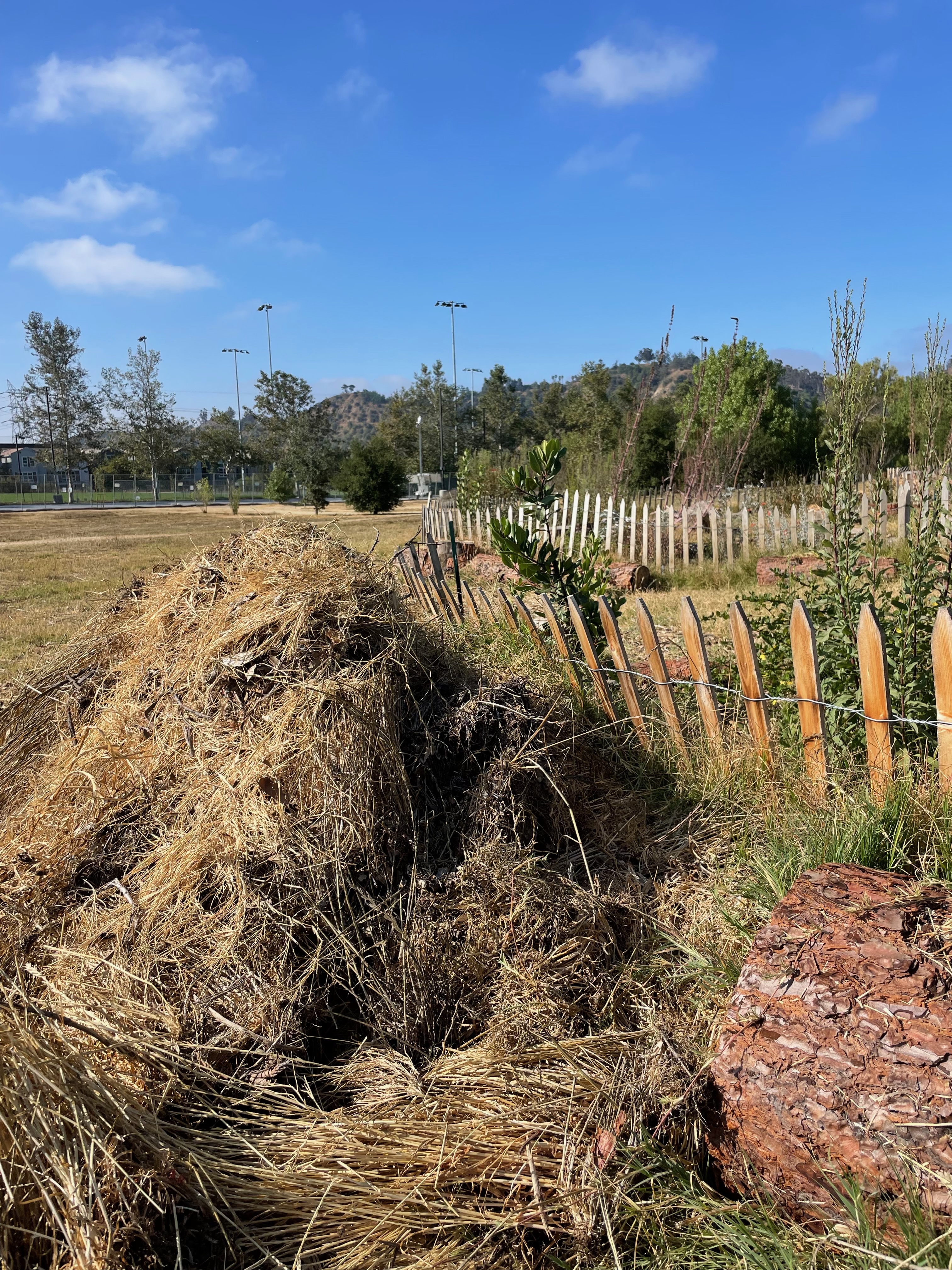
SEED COLLECTION + WORKDAY
Ohlone Hillside at Lawrence Hall of Science, Berkeley
"xǔčyun" the region that is part of the ancestral and unceded homeland of the East Bay Ohlone (pronounced "HOOCH-yoon" in Chochenyo language)
By Will Macfarlane
DATE: June 13 2025
TIME: 12pm
TEMP: 60°F – mostly sunny, moderate breeze
VOLUNTEERS: 8
My name is Will Macfarlane. I’m a landscape architecture student at UC Berkeley and an intern this summer with Terremoto and Test Plot. I’m interested in slow work – working with the land, building relationships, and supporting spaces where plants, animals, and people can all heal.
We began the morning at the roundabout in front of the Lawrence Hall of Science, where Margaret – a longtime volunteer with Skyline Gardens has spent seasons tending and seeding this area with local natives. Skyline Gardens is a 20+ year restoration project led by an amazing team of volunteers and shares the same geology, a high ridge volcanic plateau. Some of the plants were grown from seed gathered in her own backyard, others from Skyline, and some from nearby wild species. A quiet, patient experiment. Some were direct sown. Others were transplanted. All were part of a slow effort to reintroduce local ecology.
We harvested what we could, with the intent to process and reapply these seeds within the LHS Test Plot, which is about a 5 minute walk away. Being able to collect from some seed originating from Skyline Gardens, which sits on the same volcanic shelf as the LHS Test Plot, means the seeds carry local adaptation – rooted in the same soil. This kind of hyperlocal sourcing feels essential. A way to deepen our reciprocal stewardship and add resilience.
Collected seeds + Methods:
– Uropappus lindleyi / Silverpuffs (dandelion like - just grabbed handfuls of puff)
– Agoseris grandiflora / CA Dandelion (same method)
– Eschscholzia californica / California poppy (crack open the long pods when brown)
– Salvia mellifera / Black sage (turn the seed heads upside down into an envelope and tap)
– Lupinus succulentus / Succulent lupine (pop open when black)
Later in the day, we shifted to the Test Plot itself. We focused on pulling invasive oat grass and watering the established native plantings. A handful of species stood out – still holding strong after a dry spell:
– Arctostaphylos manzanita
– Pteridium aquilinum
– Ceanothus
– Stipa pulchra
– Achillea millefolium
– Gilia capitata
– Gilia tricolor
– Artemisia douglasiana
Beyond the active plot, we noticed a small stand of Eriogonum nudum / Nude buckwheat growing through oat grass on a rocky outcrop overlooking the Bay. Untouched by us, but persisting on its own.
Next steps: continue supporting what’s thriving. Maintain the edge between the plot and the surrounding weeds. Begin seed cleaning, and wait for the right season to sow. Timing, as always, matters.


